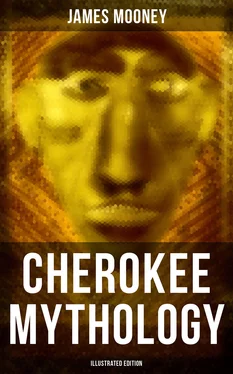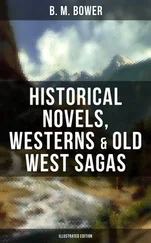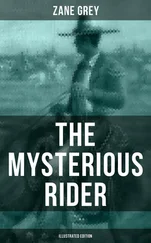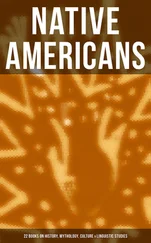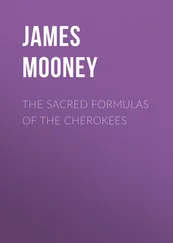From a careful sifting of the evidence Haywood concludes that the authors of the most ancient remains in Tennessee had spread over that region from the south and southwest at a very early period, but that the later occupants, the Cherokee, had entered it from the north and northeast in comparatively recent times, overrunning and exterminating the aborigines. He declares that the historical fact seems to be established that the Cherokee entered the country from Virginia, making temporary settlements upon New river and the upper Holston, until, under the continued hostile pressure from the north, they were again forced to remove farther to the south, fixing themselves upon the Little Tennessee, in what afterward became known as the middle towns. By a leading mixed blood of the tribe he was informed that they had made their first settlements within their modern home territory upon Nolichucky river, and that, having lived there for a long period, they could give no definite account of an earlier location. Echota, their capital and peace town, “claimed to be the eldest brother in the nation,” and the claim was generally acknowledged.10 In confirmation of the statement as to an early occupancy of the upper Holston region, it may be noted that “Watauga Old Fields,” now Elizabethtown, were so called from the fact that when the first white settlement within the present state of Tennessee was begun there, so early as 1769, the bottom lands were found to contain graves and other numerous ancient remains of a former Indian town which tradition ascribed to the Cherokee, whose nearest settlements were then many miles to the southward.
While the Cherokee claimed to have built the mounds on the upper Ohio, they yet, according to Haywood, expressly disclaimed the authorship of the very numerous mounds and petroglyphs in their later home territory, asserting that these ancient works had exhibited the same appearance when they themselves had first occupied the region.11 This accords with Bartram’s statement that the Cherokee, although sometimes utilizing the mounds as sites for their own town houses, were as ignorant as the whites of their origin or purpose, having only a general tradition that their forefathers had found them in much the same condition on first coming into the country.12
Although, as has been noted, Haywood expresses the opinion that the invading Cherokee had overrun and exterminated the earlier inhabitants, he says in another place, on halfbreed authority, that the newcomers found no Indians upon the waters of the Tennessee, with the exception of some Creeks living upon that river, near the mouth of the Hiwassee, the main body of that tribe being established upon and claiming all the streams to the southward.13 There is considerable evidence that the Creeks preceded the Cherokee, and within the last century they still claimed the Tennessee, or at least the Tennessee watershed, for their northern boundary.
There is a dim but persistent tradition of a strange white race preceding the Cherokee, some of the stories even going so far as to locate their former settlements and to identify them as the authors of the ancient works found in the country. The earliest reference appears to be that of Barton in 1797, on the statement of a gentleman whom he quotes as a valuable authority upon the southern tribes. “The Cheerake tell us, that when they first arrived in the country which they inhabit, they found it possessed by certain ‘moon-eyed people,’ who could not see in the day-time. These wretches they expelled.” He seems to consider them an albino race.14 Haywood, twenty-six years later, says that the invading Cherokee found “white people” near the head of the Little Tennessee, with forts extending thence down the Tennessee as far as Chickamauga creek. He gives the location of three of these forts. The Cherokee made war against them and drove them to the mouth of Big Chickamauga creek, where they entered into a treaty and agreed to remove if permitted to depart in peace. Permission being granted, they abandoned the country. Elsewhere he speaks of this extirpated white race as having extended into Kentucky and probably also into western Tennessee, according to the concurrent traditions of different tribes. He describes their houses, on what authority is not stated, as having been small circular structures of upright logs, covered with earth which had been dug out from the inside.15
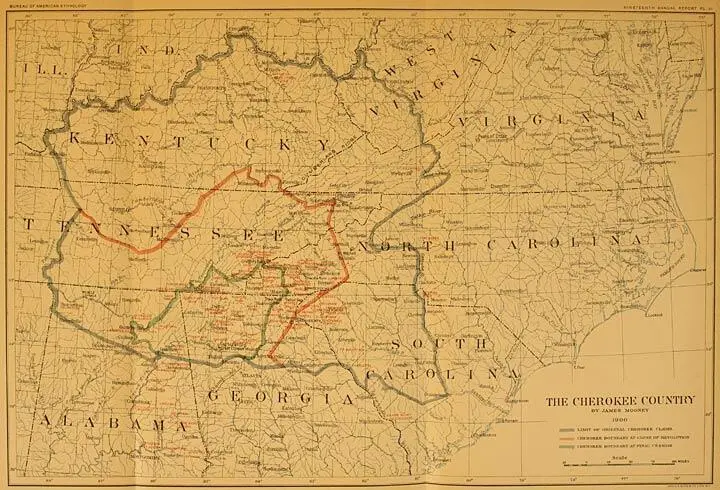
PL. III
Harry Smith, a halfbreed born about 1815, father of the late chief of the East Cherokee, informed the author that when a boy he had been told by an old woman a tradition of a race of very small people, perfectly white, who once came and lived for some time on the site of the ancient mound on the northern side of Hiwassee, at the mouth of Peachtree creek, a few miles above the present Murphy, North Carolina. They afterward removed to the West. Colonel Thomas, the white chief of the East Cherokee, born about the beginning of the century, had also heard a tradition of another race of people, who lived on Hiwassee, opposite the present Murphy, and warned the Cherokee that they must not attempt to cross over to the south side of the river or the great leech in the water would swallow them.16 They finally went west, “long before the whites came.” The two stories are plainly the same, although told independently and many miles apart.
The Period of Spanish Exploration—1540–?
Table of Contents
The definite history of the Cherokee begins with the year 1540, at which date we find them already established, where they were always afterward known, in the mountains of Carolina and Georgia. The earliest Spanish adventurers failed to penetrate so far into the interior, and the first entry into their country was made by De Soto, advancing up the Savannah on his fruitless quest for gold, in May of that year.
While at Cofitachiqui, an important Indian town on the lower Savannah governed by a “queen,” the Spaniards had found hatchets and other objects of copper, some of which was of finer color and appeared to be mixed with gold, although they had no means of testing it.17 On inquiry they were told that the metal had come from an interior mountain province called Chisca, but the country was represented as thinly peopled and the way as impassable for horses. Some time before, while advancing through eastern Georgia, they had heard also of a rich and plentiful province called Coça, toward the northwest, and by the people of Cofitachiqui they were now told that Chiaha, the nearest town of Coça province, was twelve days inland. As both men and animals were already nearly exhausted from hunger and hard travel, and the Indians either could not or would not furnish sufficient provision for their needs, De Soto determined not to attempt the passage of the mountains then, but to push on at once to Coça, there to rest and recuperate before undertaking further exploration. In the meantime he hoped also to obtain more definite information concerning the mines. As the chief purpose of the expedition was the discovery of the mines, many of the officers regarded this change of plan as a mistake, and favored staying where they were until the new crop should be ripened, then to go directly into the mountains, but as the general was “a stern man and of few words,” none ventured to oppose his resolution.18 The province of Coça was the territory of the Creek Indians, called Ani′-Kusa by the Cherokee, from Kusa, or Coosa, their ancient capital, while Chiaha was identical with Chehaw, one of the principal Creek towns on Chattahoochee river. Cofitachiqui may have been the capital of the Uchee Indians.
Читать дальше
